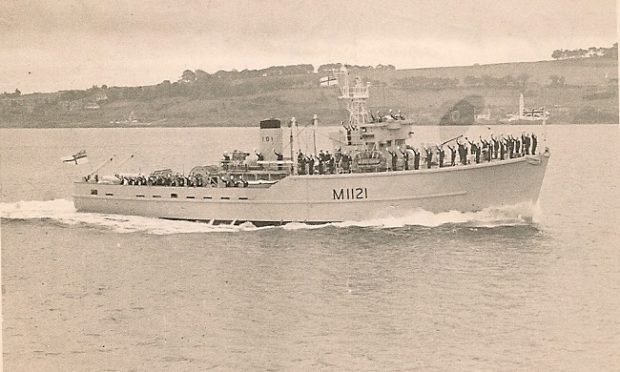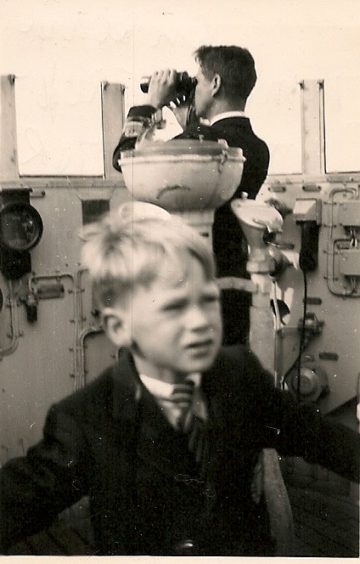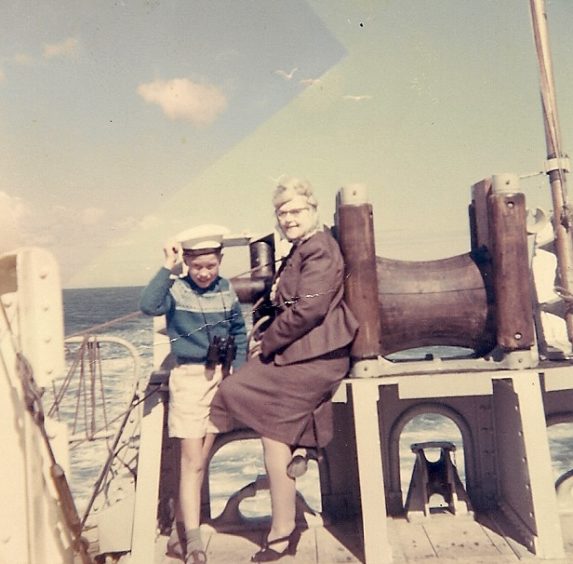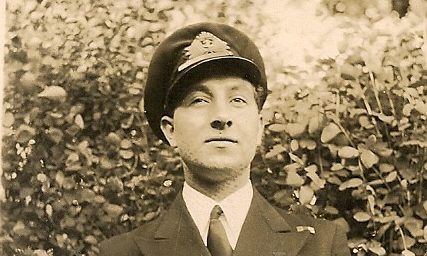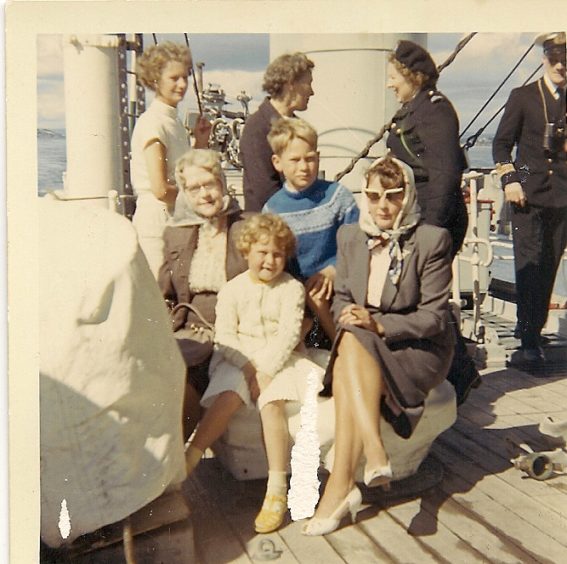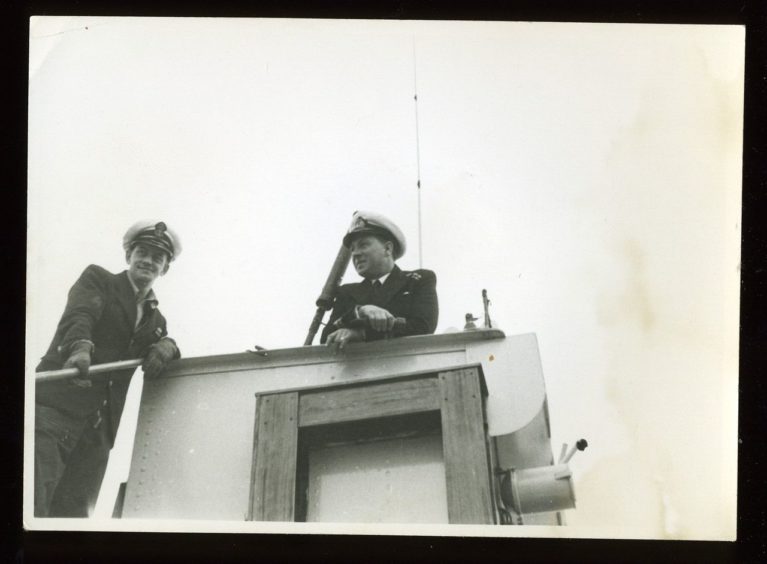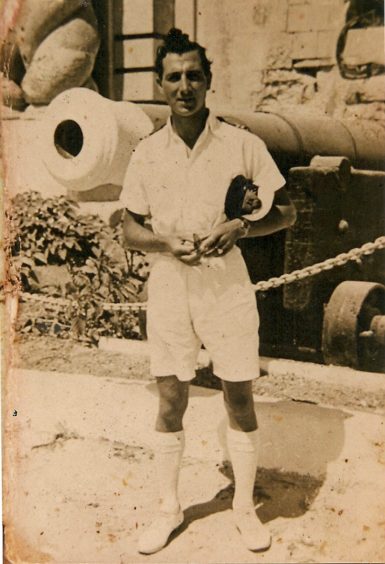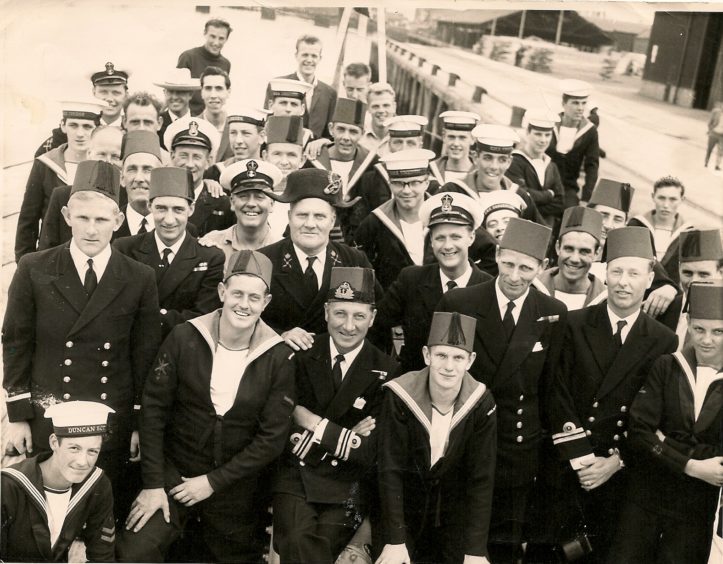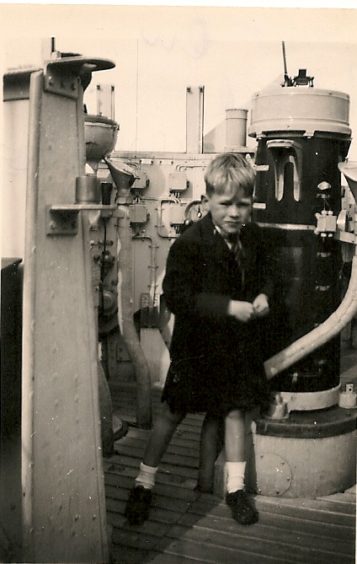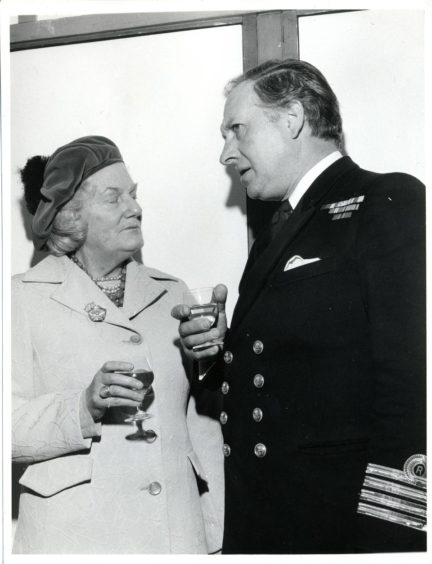He was the late Dundee naval hero who was actively involved in the D-Day Landings and the Arctic convoys.
Captain Andrew Robertson Mackie, who would have turned 100 today, then went on to command the minesweeper HMS Montrose on several NATO training exercises to countries bordering the North Sea and Mediterranean during the Cold War.
Peeled potatoes
He took his son Mike along on a couple of these exercises and the time they spent together has remained etched in his son’s memory.
“One was to Zandaam in the Netherlands and the other to Frederikssund in Denmark,” said Mike.
“I peeled potatoes and scrubbed the decks!
“I have vivid childhood memories of times spent onboard Montrose and at sea in her.”
When he found out that Montrose was about to be scrapped in Australia he set himself the task of recovering an artefact from the doomed warship.
Montrose was purchased by the Royal Australian Navy (RAN) in the 1960s and will now be sunk on site at Margate Marina where she is holding up Tasmania’s $20m state-of-the-art boating complex.
Mike has managed to get a small sliver of rotting timber planking and a couple of paint chips sent to him from the deck which he walked on with his father.
“As a boy, I knew that my father had served in the navy during the war,” said Mike.
“However, my father did not discuss the war with me as, I assume, memories of it were all too fresh.
“At school, history books also stopped after the First World War.
“I was thus rather ignorant of the war and of my father’s role in it until much later in life after he joined various veterans’ associations and started recounting his memories.
“But it was only after his death in 2013 aged 92 when the family compiled his obituary that I gained a fuller appreciation.
“This quest had at its root my father’s wartime and post-war service, the influence that this has had on me, and was undertaken in what would have been his hundredth year.
“All of this and much more is now represented in the simple memento I have obtained.
“This is all I ever wanted and much more.”
Mr Mackie was born in Forfar, the eldest of three brothers, whose father was a policeman who transferred from Angus to Dundee.
He found himself head of the family after his father died and his widowed mother went to work as a school cleaner to supplement her meagre pension as a war widow.
He was educated at Morgan Academy and was a keen member of the Boys’ Brigade at Mains Church near his home in Claverhouse Road.
Arctic convoys
Mr Mackie left school early to bring in much needed extra income and went to work in a solicitor’s office with a view to pursuing law as a profession but when war broke out he joined the Royal Navy as a junior rating in 1940.
Even during his early training days in Sussex, he experienced the war very early on when German aircraft attacked his vessel in Shoreham Harbour.
After initial training he was thrown into the thick of battle on escort duties, criss-crossing the Atlantic in the corvette HMS Pimpernel.
Following promotion he served as a young officer on ships large and small and saw active service in the North Atlantic, West Indies, the Mediterranean as well as participating in the perilous Arctic convoys.
The convoys were under constant threat of attack by German U-boats and aircraft and had to endure severe cold, storms and ice floes in what Winston Churchill described as ‘the worst journey in the world’.
One of his many wartime stories included inadvertently orchestrating a strike in Liverpool Dockyard by setting his ship’s company to painting the newly issued camouflage scheme before the ship sailed on for escort duties – of which the dockyard “mateys” did not approve.
The Admiral eventually intervened and they moved the ship to an out-of-sight berth and carried on painting before setting sail across the Atlantic once more.
He was also actively involved in the D-Day landings, fending off German U-boats, and, after the war, Mr Mackie was selected to stay in service and became 1st Lieutenant of HMS St Angelo the Naval Headquarters in Valletta, Malta.
In 1952, he was promoted to Lieutenant with Tay Division RNR based onboard HMS Unicorn where his daughter Sarah was christened.
He served for many years with HMS Montrose and a promotion to Lieutenant Commander followed in 1958 where his experiences from the war prepared him for the rigours of mine-sweeping in rough weather.
Mr Mackie was awarded Volunteer Reserve Decoration in September 1963 and then appointed Executive Officer Tay Division RNR as a Commander in 1965.
In 1970, he was promoted to captain and appointed Commanding Officer Tay Division RNR.
He later took command of HMS Camperdown, the new shore headquarters for the division.
One of the many highlights of Mr Mackie’s command was the renaming of HMS Stubbington to Montrose in 1972 when he arranged for Lady Lambe (widow to Sir Charles Lambe, Admiral of the Fleet) to conduct the official renaming.
Before the renaming, Mr Mackie also orchestrated for HMS Montrose to make the journey up the River Tay to Perth Harbour.
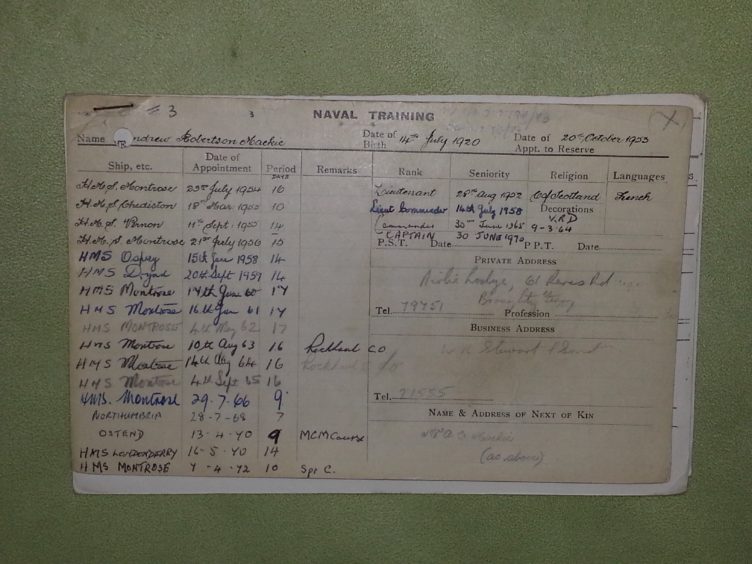
This was quite an unusual occurrence as it was the only time a ‘Ton’ Class had got that far and the vessel even had to sit on the mud overnight at low tide.
There were other notable trips on HMS Montrose under Mr Mackie’s command including a memorable stop at Tangiers while on a Gibraltar exercise.
He was awarded Clasp to the Voluntary Reserve Decoration in 1973 before retiring in 1975.
Pillars of society
His two brothers, Ian and Bruce, also went on to become pillars of society serving in local government in Dundee over many years.
Ian was made a CBE and Bruce awarded an OBE.
With his ongoing interest in the sea, Mr Mackie joined the Royal Tay Yacht Club and was made a life member.
Mr Mackie’s civilian career saw him first enter the tyre trade as a management trainee with Dunlop.
He later joined Wm R Stewart & Sons (Hacklemakers) in Dundee which manufactured hackles which are pinned rollers used primarily in the teasing of jute and its conversion into fibre for spinning.
As marketing director Mr Mackie enjoyed travelling around the globe.
He became a Fellow of the Institute of Directors in 1980 and an elected member of the Chartered Institute of Marketing.
In his retirement, he continued to maintain active contact with the RNR and remained a staunch supporter of the Unicorn Preservation Trust.
He was a lifelong member of the Naval Club in London, the Association of Naval Officers, the Britannia Association and the Ton Class (minesweeper) Association.
He married Audrey in 1949 and the couple went on to renew their wedding vows on their Golden Wedding Anniversary in 1999, officiated by the late Canon John O’ Farrell (Naval Padre for Tay Division RNR).
Mr and Mrs Mackie lived at East Haven and then Broughty Ferry.
Mrs Mackie died in 2003 and in his later years Mr Mackie suffered a series of debilitating strokes but soldiered on at his home overlooking the River Tay until his death in 2013.
Mr Mackie was survived by Mike and daughters Gail and Sarah.
He was also a grandfather and a great-grandfather at the time of his passing.
Mr Mackie’s ashes were committed to the English Channel in 2014 to mark the 70th anniversary of D-Day.
Memorial trophy
The family also decided to establish a trophy in his honour for HMS Duncan which has a connection with Mr Mackie.
The headquarters of the RNR of which Mr Mackie was Captain in the 1970s was HMS Camperdown – named after the battle famously won against the Dutch Navy.
The relationship with HMS Duncan is cemented further because the defensive operations off the Normandy beaches in which Mr Mackie was involved included not just his ship, HMS Northern Sun, but also the-then destroyer, HMS Duncan.
Finally at the time of his interment at sea, HMS Duncan was berthed in Portsmouth and hosted his family after the service at which the idea of a memorial trophy was floated.
